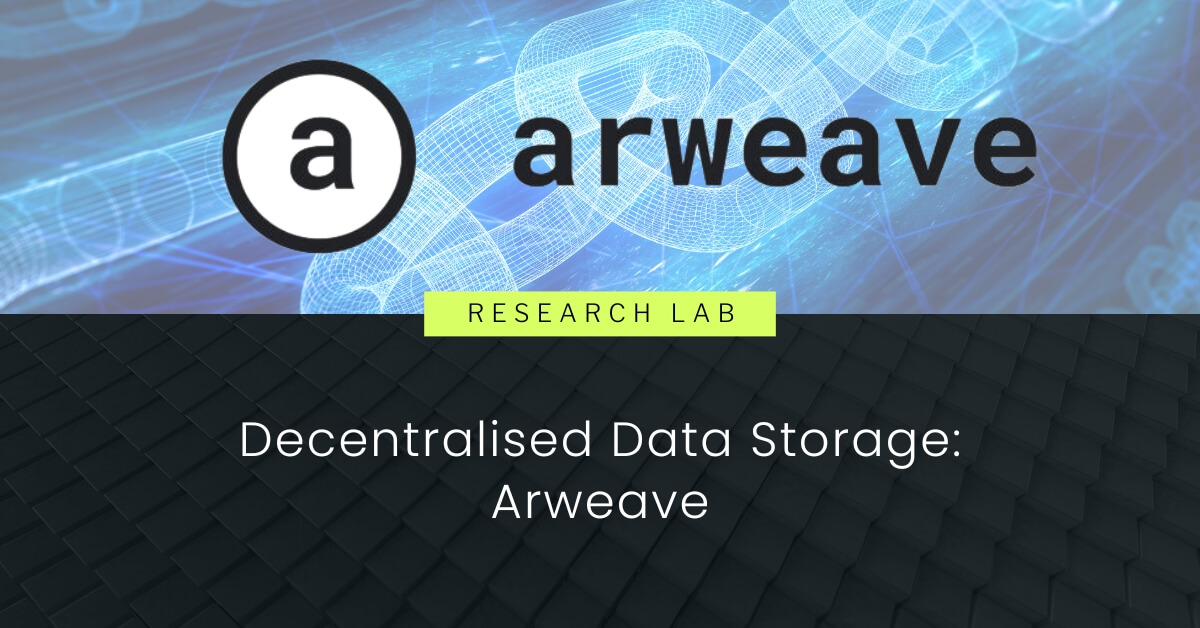Content
- What is Arweave?
- How Does it Work?
- How Does Arweave Achieve Permanence?
- Understanding Storage Endowment
- What is the Permaweb
- Permanent File Storage
- Permanent Blockchain Data Storage
- Permanent Decentralised Applications
- Arweave Layer 2
- Smart Contracts on Arweave
- Profit-Sharing Communities
- Conclusion
- About Zerocap
- DISCLAIMER
- FAQs
- What is Arweave and how does it address data impermanence on the internet?
- How does Arweave's blockweave data structure work?
- How does Arweave achieve data permanence?
- What is the Permaweb in the context of Arweave?
- What are the applications of Arweave's permanent data storage?
14 Apr, 23
Decentralised Data Storage: Arweave

- What is Arweave?
- How Does it Work?
- How Does Arweave Achieve Permanence?
- Understanding Storage Endowment
- What is the Permaweb
- Permanent File Storage
- Permanent Blockchain Data Storage
- Permanent Decentralised Applications
- Arweave Layer 2
- Smart Contracts on Arweave
- Profit-Sharing Communities
- Conclusion
- About Zerocap
- DISCLAIMER
- FAQs
- What is Arweave and how does it address data impermanence on the internet?
- How does Arweave's blockweave data structure work?
- How does Arweave achieve data permanence?
- What is the Permaweb in the context of Arweave?
- What are the applications of Arweave's permanent data storage?
What is Arweave?
The term ‘the internet is forever’ is a common phrase used to explain the permanence of data on the internet. However, this phrase is not entirely true. Websites, data, and other material that comprise the content of the internet are often changed, redacted, and in some cases, removed altogether. Data storage is largely controlled by a few centralised entities who mediate our access to websites and apps and can accordingly revoke it at any time. As opposed to Filecoin which allows users to rent storage space, Arweave has developed a permanent file storage solution. Founded by Sam Williams in 2017, the protocol aims to resolve the issue of data impermanence on the internet.

How Does it Work?
Arweave utilises a unique data structure called blockweave, which is an iteration of the traditional blockchain design reworked to enable the permanent storage of large datasets. Each block in the blockweave is linked to two previous blocks: the immediately preceding block and a randomly selected block from the network’s history, known as the “recall block”. Miners must have access to this recall block in order to mine new blocks and earn rewards through the consensus mechanism called Succinct Proofs of Random Access (SPoRA). The unpredictable choice of recall block incentivizes miners to store a larger amount of data, increasing their chances of having access to the correct recall block and earning rewards. Additionally, encourages miners to store rarer blocks instead of well-replicated ones, as they will be competing with a smaller number of miners for rewards.
How Does Arweave Achieve Permanence?
Historically, data storage providers have been unable to provide a guarantee of absolute permanence for their clients’ data. This is not due to a lack of technology, as it is possible to build fault-tolerant and consistently available storage systems, demonstrated by the success of projects like Filecoin. Rather, the issue lies in the lack of an appropriate economic incentives model for permanent data storage. In the traditional model, if a client stops paying for storage, their data will cease to exist. In Arweave, users pay a one-time fee in Arweave (AR) tokens for permanent storage. Miners, who are responsible for creating new blocks and thereby storing the data, are rewarded with these tokens. One portion of the fee (about 15% based on the current price of storage) is used to cover 200 years of storage costs and is paid out to the miner incrementally over the 200-year period. The other 85% is held in “endowment”.
Understanding Storage Endowment
The volume of funds used to pay miners from an endowment is calculated by the cost of data storage. Data storage costs have been on a steady decline for decades, this can be measured by utilising a trend known as the Kryder rate for HDDs and Moore’s Law for SSDs. These trends are expected to continue as technology improves and data density increases. Arweave takes advantage of this price pattern by offering permanent data storage at a fixed cost, and by charging an up-front fee. This up-front fee is calculated to last a minimum of 200 years with the expectation that the cost of data storage does not improve over that lifetime.
Historically, the Kryder Rate was around 100 Tb/in²/yr in the early 2000s, but it has since dropped to around 20 Tb/in²/yr in recent years. Showing that the cost of storage is getting cheaper every year. However, the rate of cost depreciation is also depreciating. Based on the current trend, it is expected that the Kryder rate will continue to decline into the future and may eventually plateau, reaching as low as 2-5 Tb/in²/yr. With the introduction of Solid State Drives (SSD), there has been a shift in focus from the Kryder Rate to Moore’s Law as a measure of progress in the storage industry. Moore’s Law, which states that the number of transistors on a microchip will double every two years, has been a driving force behind the rapid growth and development of computing technology over the past few decades. Applying Moore’s Law to SSDs, we can expect to see a similar rate of improvement in storage capacity and performance over time. As the technology behind SSDs continues to advance, it is likely that we will see an increase in storage capacity and a decrease in cost, independent of the Kryder Rate.

With the implementation of the Arweave 2.6 upgrade, the network will seamlessly determine both Moore’s Law for SSDs and the Kryder Rate for HDDs by responding to the storage price offered by miners. The network can function as a trustless oracle for this price, as miners are incentivised to minimise costs through competition with one another. Assuming typical commodity-like volatility levels of approximately 2-5%, as estimated by the World Bank, we can see that a Kryder+ rate of less than 0.76% will result in a lifespan of the endowment exceeding 10,000 years.
Furthermore, the storage endowment serves as an economic incentive that aligns network usage with the price of the token. As users pay for storage using AR, a significant portion of those tokens are locked for 200 – 10,000 years. This creates a dynamic where a decrease in token supply coincides with an increase in token demand, thereby exerting upward pressure on the price of the AR token. Conversely, if demand for Arweave storage were to decline, it would result in fewer tokens being locked up over time and endowment funding releasing tokens into the circulating supply, exerting downward pressure on the price of the AR token.
What is the Permaweb
The permaweb sits atop the Arweave network, providing a global, community-owned web accessible to anyone who wishes to contribute or earn a living through maintaining it. Users can store any type of data on the Arweave network, including text, images, and even entire websites. This data is broken down into small chunks called ‘transactions’ and each transaction is added to a block in the blockweave. The data is then replicated across the network, ensuring that it is always available and can be easily accessed by anyone.
Permanent File Storage
Decentralised applications such as Ardrive and Evermore allow anyone to upload files to the permaweb, acting as a layer of abstraction so users do not get lost in the technicalities of uploading directly to Arweave. These applications function in a similar fashion to traditional file storage tools like Dropbox or Google Drive – lowering the barrier to entry by allowing non-technical users to upload data to the permaweb. Additionally, users can now upload data to the permaweb with the official Arweave Web Wallet.
On July 15, 2020, Arweave announced a strategic partnership with Internet Archive to store website metadata collected by the Wayback Machine on the Arweave network. This collaboration enables the permanent and immutable storage of website data on the Arweave blockchain, creating a tamper-proof record of the historical evolution of the web. The partnership ensures the longevity and accessibility of the data, even in the event of website deactivation or discontinuation of maintenance. Furthermore, the decentralised nature of the Arweave network enhances the resistance of the data to censorship and other forms of tampering.
Permanent Blockchain Data Storage
Protocols such as Solana, Avalanche, Polkadot and Cosmos use Arweave to store historic blockchain data securely. Blockchain protocols require transaction data to be permanently stored. While this might not be a huge issue for protocols like Bitcoin and Ethereum, data storage is a key issue for high-throughput blockchain protocols. Arweave enables these types of protocols to focus less on data preservation and more on transaction throughput.
Permanent Decentralised Applications
Many ‘decentralised’ applications today use centralised cloud infrastructure such as Google Cloud and Amazon Web Services to host their applications on the web. While the core functions of the back end exist on-chain, the front end acts as a central point of failure making it vulnerable to downtime and censorship. An example of this is Uniswap: Uniswap made headlines on July 23, 2021 when Uniswap Labs altered the front end to hide roughly 100 tokens from the user interface. However, permaweb archivists were able to clone Uniswap’s previous user interface and host it permanently on Arweave.
Arweave Layer 2
Bundlr acts as a layer 2 scaling solution on top of Arweave, increasing the transaction throughput of Arweave from 30,000 transactions per hour on the layer 1 to over 50,000 transactions per second on Bundlr. Additionally, Bundlr provides an array of developer tools to make it improve the experience of using Arweave; these include file compression, file encryption, file organisation, custom landing pages, as well as the ability to pay for storage in an array of third-party cryptocurrencies other than AR.
Smart Contracts on Arweave
SmartWeave is an additional layer on top of the Arweave protocol that allows for the creation and execution of smart contracts on the network. Just like Ethereum, these smart contracts can be used to create decentralised applications. However, Smartweave can be more cost-efficient due to the fact that it is capable of storing large quantities of data at a low price.
Profit-Sharing Communities
Profit-sharing communities in Arweave are groups of users who pool their resources together to collectively fund the storage and upkeep of data on the Arweave network. The profits generated by these stored data are then shared among the members of the community according to their contributions. These communities can be created by anyone and the data they store can be any type of information, such as documents, videos, or images. The purpose of these communities is to provide a decentralised and community-driven alternative to traditional data storage solutions.
Conclusion
Arweave is a permanent and decentralised data storage solution that aims to resolve the issue of data impermanence on the internet. With a unique blockchain-like structure, the blockweave, allows for the storage of large datasets and incentivizes miners to store a larger amount of data through the use of the SPoRA consensus mechanism. The network guarantees permanence by charging a one-time fee in AR tokens for permanent storage and using a portion of the fee to cover 200 years of storage costs and the other portion to hold an endowment. With its unique approach and growing adoption, Arweave has proven itself to not only be valuable to the web3 ecosystem but humanity as a whole – providing verifiable permanent data storage for the first time in existence.
About Zerocap
Zerocap provides digital asset investment and digital asset custodial services to forward-thinking investors and institutions globally. For frictionless access to digital assets with industry-leading security, contact our team at [email protected] or visit our website www.zerocap.com
DISCLAIMER
Zerocap Pty Ltd carries out regulated and unregulated activities.
Spot crypto-asset services and products offered by Zerocap are not regulated by ASIC. Zerocap Pty Ltd is registered with AUSTRAC as a DCE (digital currency exchange) service provider (DCE100635539-001).
Regulated services and products include structured products (derivatives) and funds (managed investment schemes) are available to Wholesale Clients only as per Sections 761GA and 708(10) of the Corporations Act 2001 (Cth) (Sophisticated/Wholesale Client). To serve these products, Zerocap Pty Ltd is a Corporate Authorised Representative (CAR: 001289130) of AFSL 340799
All material in this website is intended for illustrative purposes and general information only. It does not constitute financial advice nor does it take into account your investment objectives, financial situation or particular needs. You should consider the information in light of your objectives, financial situation and needs before making any decision about whether to acquire or dispose of any digital asset. Investments in digital assets can be risky and you may lose your investment. Past performance is no indication of future performance.
FAQs
What is Arweave and how does it address data impermanence on the internet?
Arweave is a protocol that aims to resolve the issue of data impermanence on the internet. Unlike Filecoin, which allows users to rent storage space, Arweave has developed a permanent file storage solution. It uses a unique data structure called blockweave, an iteration of the traditional blockchain design reworked to enable the permanent storage of large datasets.
How does Arweave’s blockweave data structure work?
Each block in the blockweave is linked to two previous blocks: the immediately preceding block and a randomly selected block from the network’s history, known as the “recall block”. Miners must have access to this recall block in order to mine new blocks and earn rewards through the consensus mechanism called Succinct Proofs of Random Access (SPoRA). The unpredictable choice of recall block incentivizes miners to store a larger amount of data, increasing their chances of having access to the correct recall block and earning rewards.
How does Arweave achieve data permanence?
Arweave achieves data permanence by charging a one-time fee in Arweave (AR) tokens for permanent storage. Miners, who are responsible for creating new blocks and thereby storing the data, are rewarded with these tokens. One portion of the fee (about 15% based on the current price of storage) is used to cover 200 years of storage costs and is paid out to the miner incrementally over the 200-year period. The other 85% is held in “endowment”.
What is the Permaweb in the context of Arweave?
The permaweb sits atop the Arweave network, providing a global, community-owned web accessible to anyone who wishes to contribute or earn a living through maintaining it. Users can store any type of data on the Arweave network, including text, images, and even entire websites. This data is broken down into small chunks called ‘transactions’ and each transaction is added to a block in the blockweave. The data is then replicated across the network, ensuring that it is always available and can be easily accessed by anyone.
What are the applications of Arweave’s permanent data storage?
Arweave’s permanent data storage has a wide range of applications. Decentralised applications such as Ardrive and Evermore allow anyone to upload files to the permaweb. Protocols such as Solana, Avalanche, Polkadot and Cosmos use Arweave to store historic blockchain data securely. Many ‘decentralised’ applications today use centralised cloud infrastructure such as Google Cloud and Amazon Web Services to host their applications on the web. However, permaweb archivists were able to clone Uniswap’s previous user interface and host it permanently on Arweave.
Like this article? Share
Latest Insights
Bitcoin Halving: Market Reacts
The 2024 Bitcoin halving, a significant event for the cryptocurrency world, marked a notable shift in the market dynamics of Bitcoin. As the block reward
Weekly Crypto Market Wrap, 22nd April 2024
Download the PDF Zerocap provides digital asset liquidity and digital asset custodial services to forward-thinking investors and institutions globally. For frictionless access to digital assets
Ethereum Smart Contracts: How They Changed Crypto
Ethereum, launched in 2015, revolutionized the digital world by introducing “smart contracts,” self-executing contracts with the terms of the agreement directly written into code. This
Receive Our Insights
Subscribe to receive our publications in newsletter format — the best way to stay informed about crypto asset market trends and topics.



 Share
Share  Tweet
Tweet  Post
Post 